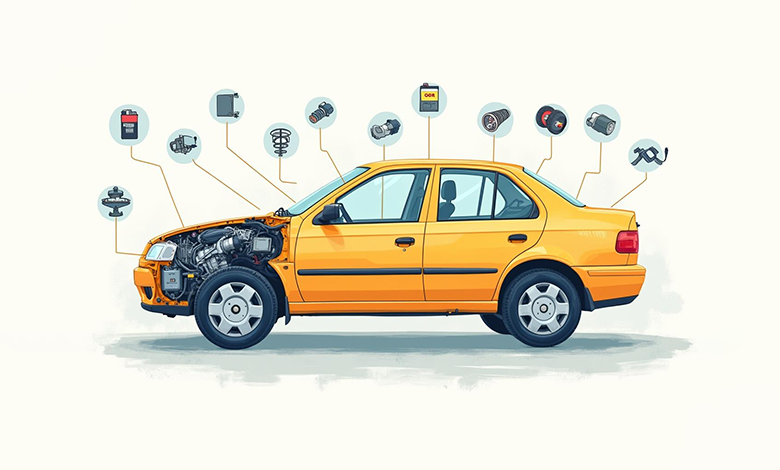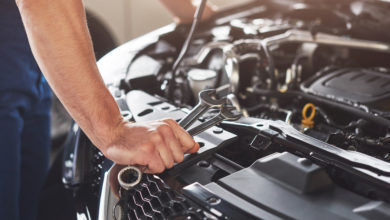10 Essential Car Parts Every Driver Should Know

Responsible drivers should have a basic understanding of key car components. Driving a car is not limited to just operating the steering wheel and accelerator to reach the destination. It is also important to have an adequate understanding of car parts to maintain the car and get long-lasting performance. Knowing how these parts work can help in emergencies and reduce repair costs.
The important parts of a car are basically – the engine, transmission, alternator, suspension, brakes, fuel tank, tires or wheels, steering, gear stick, catalytic converter, radiator, muffler, windshield, wiper, air filter, etc. This blog discusses in detail 10 important car parts that drivers should know.
(1) Engine Mechanism
The engine is the main part of any motorized vehicle. The heart of a car is the engine. It produces power from fuel, i.e., converts fuel into mechanical energy. Car engines can be of different types – petrol, diesel, hybrid, CNG, electric, etc.
It is difficult for a driver to have an idea about the entire engine mechanism. However, it is necessary to have an idea about some common things. For example, overheating, thermostat, dead battery, ignition system, spark plug, oil leak, filter, carbon buildup, etc.
(2) Clutch
The clutch is an essential part of a manual car. It helps in disconnecting the engine and gearbox during gear changes. It helps in changing and controlling the speed of the car. If the clutch is in good condition, there is no jolt or jerk during gear changes. Therefore, regular clutch maintenance is required. A driver should have an idea about the symptoms of clutch slipping, clutch plate-disc-spring, clutch cable, clutch grabbing, clutch release bearing, clutch becoming hard, etc.
(3) Battery System
The battery helps in starting the car engine and keeping all the electrical systems (such as headlights, infotainment systems, electronic devices, etc.) running. If the battery charge and connection are not checked regularly, the battery’s health decreases rapidly. A driver should have an idea about battery circuit problems, battery cells, overheating, oxidation/carbon buildup, alternator problems, etc.
(4) Brake System
The brake system is used to stop the car and reduce its speed. It is an important part of the safety of the car. The braking system consists of discs, drums, brake pads, fluid, etc. A car’s brake system will last longer if it is regularly checked for brake pads, brake fluid leaks, hydraulic pressure, brake caliper sticking, brake line blockage or contamination, antilock braking system, etc.
(5) Steering System
The steering wheel is used to change and control the direction of the vehicle. It can be manual or power steering. It is very important for the driver, as it helps in controlling the vehicle. The driver should have an idea about whether the steering is too tight or too loose, the steering bearing system, the steering gear friction, the steering fluid problems, etc.
(6) Suspension System
The suspension maintains stability by absorbing the shock of the speed breaker on the road and ensures a comfortable drive. The suspension system includes various parts such as shock absorbers, struts, ball joints, bushings, and springs. Regularly checking the suspension and replacing the shock absorbers, springs, and ball joints on time will keep the suspension in good condition.
(7) Fuel Pump and Fuel Injection System
The fuel pump and fuel injection system of the car, along with the fuel tank, helps the engine to work properly by supplying fuel. The driver should be aware of problems such as a burnt fuel pump, low-quality fuel, low fuel pressure, a clogged fuel filter, a clogged injector, a leaking fuel injector, etc. Due to such problems, the mileage of the car decreases, misfires, black smoke from the exhaust, etc. These problems are reduced in the long run if the fuel pump and injector are cleaned regularly and good-quality fuel is used.
(8) Exhaust System
The exhaust system mainly emits smoke and gas produced by the engine. It also controls the noise of the car and makes it environmentally friendly. Common problems with exhaust systems include cracked or rusted pipes and silencers, damaged catalytic converters, damaged mufflers, cracked exhaust manifolds, broken exhaust hangers, etc.
(9) Wheels and Tires
Wheels and tires bear the entire weight of the vehicle, and issues with them can affect safety, control, and driving comfort. The driver needs to keep an eye on tire tread wear, proper pressure, grip, wheel alignment, balancing problems, damaged rims, etc.
(10) Headlights, Taillights, and Turn Signals
The headlights, taillights, and turn signals of a car are very important for driving at night, giving directions, and communicating signals. Most lighting issues are caused by faulty wiring, blown fuses, or water-damaged circuits. Other common problems include burnt bulbs, blown fuses, damaged switches, water-logged circuits, loose connections, etc.
Drivers should be aware of some other common car parts –
(1) The alternator keeps the battery charged and the electrical system running.
(2) The radiator helps keep the engine cool and prevents overheating.
(3) The air filter purifies the air.
(4) The dashboard and gauges can be used to monitor the car’s speed, oil, battery charge, etc.
(5) Bumpers protect the front and rear of the car.
(6) Airbags and seat belts protect passengers during a collision.
(7) Anti-lock braking system helps maintain control of the car.
Finally, having a basic understanding of the important car parts of the car is essential for the safety and responsibility of a driver. With basic knowledge of the above-mentioned topics, you can make quick and correct decisions in any unexpected situation. These simple tips will save you a lot of maintenance costs.





